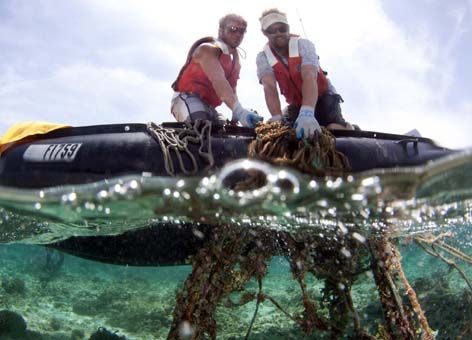Follow Along as NOAA Clears the Waters of the Northwestern Hawaiian Islands
OCTOBER 8, 2014 -- Turquoise waters, vibrant coral reefs, white sand beaches—this is often what we think of when we think about far-off islands in the Pacific Ocean. But even the furthest reaches of wilderness, such as the tropical reefs, islands, and atolls of the Papahānaumokuākea Marine National Monument, which are hundreds of miles from the main Hawaiian archipelago, can be polluted by human influence. In these shallow waters, roughly 52 tons of plastic fishing nets wash up on coral reefs and shorelines each year. For nearly two decades, NOAA has been leading an annual mission to clean up these old nets that can smother corals and entangle marine life, including endangered Hawaiian monk seals. This year, the NOAA Marine Debris Program has two staff—Dianna Parker and Kyle Koyanagi—joining the NOAA Pacific Islands Fisheries Science Center scientists and divers on board the NOAA Ship Oscar Elton Sette to document this effort. You can follow their journey to remove nets from five areas in the marine monument:
- Their first big stop was at Maro Reef, where in the first two days intrepid divers removed more than 8,000 pounds of fishing nets from the largest coral reef in the Northwestern Hawaiian Islands and after six days of work, have increased that to more than 15 tons (14 metric tons).
- Learn about the highly trained marine debris divers who—with the help of GIS mapping technology but without SCUBA gear—scope out and haul up thousands of pounds of nets, which are often covered in varying degrees of algae and other marine life, while trying to avoid being caught in the nets themselves.
- Find out how this marine debris mission got a recent boost after an unfortunate mishap left a NOAA-chartered vessel grounded on coral on Pearl and Hermes Atoll.
- Get the scoop on the mission’s origins, the cultural and natural gems of this marine monument, and where all of those fishing nets come from.
- And finally discover where your lost flip flop has been … on an atoll 1,200 miles from the nearest city.
You can keep track of all things related to this expedition on the NOAA Marine Debris Program website.
 An official website of the United States government.
An official website of the United States government. 

